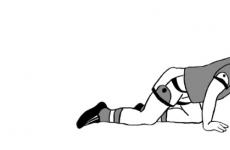Draft floors in a wooden house. Draft floor in a wooden house: what it is eaten with
Everyone knows that it is not possible to fully live in an apartment or house without an equipped floor. It is simply necessary. Is it worth it to do it wooden house- this question worries many. Their logic boils down to the fact that why spend money on an additional subfloor, it might be easier to just lay a finishing one right away. Everything is ambiguous here.
Of course, you can get by with a fair one, but in this case you will not be able to get a reliable and beautiful coating. But the main thing that the floor should stand out with is reliability, strength, a flat surface, as well as some other parameters that are extremely difficult to achieve without a subfloor. Changing the final floor every year, if there is no rough one, is an unaffordable luxury.
Photo: draft floor in a wooden house
Draft floor - what is it?
A subfloor is a special base for a finishing floor, which forms a flat horizontal plane for it. The subfloor provides distribution of the load that acts on the floor covering.
In a wooden house, the draft floor can be done in several ways:
- wooden on logs;
- plywood flooring;
- pouring concrete.
Wooden draft floor on logs
In a wooden house, the installation of a subfloor on logs practically does not differ from its installation in monolithic or brick houses. The main difference is in the fastening of the lag.

General scheme devices
lag mount
Floor logs should not be attached to wooden wall, and you don't have to hit it. It is advisable to fix the logs to the plinth or grillage of the foundation, retreating from the wall by a few centimeters. At the same time, the distance of the support, which falls on the foundation, must be observed at least 10 cm on either side of the log.
Legs are attached to the plinth
Before laying the logs on the foundation, you need to lay the lower harness, made of long thin boards, to which the logs will be attached using metal anchors (corners).
The lags should not be fixed rigidly to the harness - they only need to be fixed so that they do not travel while laying other layers of the subfloor. The created structure will have a few cm indent from each wall, where thin insulation can be installed.
Definitely need waterproofing
If the distance to the foundation is less than 10 cm, then it is better to crash into the walls, however, it will be necessary to initially lay the lags on the foundation, and then attach a log or beam to them. Measure the contour of the cutout and then cut out the necessary grooves in the wood with the dimensions necessary for the distance of the support (for subsequent expansion, the lag should be added about 2 cm).
Do not forget that the laying of beams and lags is carried out on the plinth or grillage only after laying the waterproofing layer.

Lags are attached to the foundation grillage
The standard step between the lags is 40-60 cm. However, its choice depends on the width of the insulation, as well as the direct load. The lag section is also selected from the current load. With a light section, choose 15 × 10 cm, with an average - 15 × 15 cm, with a heavy one - 15 × 20 cm.
If the beam has a small cross section, and the effect of the load is significant, then it must be placed at a distance of 30-40 cm - this is a fairly optimal option.
Installation of the subfloor on the logs
With the end of the laying of the log, the standard installation of the floor on the logs is carried out. It looks like this:


Between the insulation and the floorboard you need to leave a ventilation gap
Important! Boards, bars and logs should be treated with an antiseptic to prevent them from being exposed to various fungi and insects.
Subfloor plywood
A plywood floor will serve reliably for a long time. She has high strength. Plywood can even be used for final flooring, as if carefully sanded and varnished, it will look quite noble. However, it is more often used as a base for coating with laminate, parquet and linoleum.

Laying plywood on an old floor
Plywood can be laid:
- On cement base, but it is necessary to ensure the evenness and horizontalness of the base, or use adjusting racks.
- Fastening on the logs. Here the difficulty is the exposure of the lags to ensure that the joints of the sheets hit them. Logs must be set so that their upper surface provides one horizontal plane. Engineering communications are hidden in the logs, insulation and sound insulation are laid.

Laying plywood on logs
Important! When laying plywood in one layer, it is necessary that its thickness be at least 15 mm, if in two layers, then you need to choose at least 9 mm for the layer.
All dust and debris must be removed from the subfloor before final laying of the plywood. It is also desirable to perform priming, that is, to process with a special primer.
Longevity and excellent aesthetic characteristics of the finishing flooring are provided by the subfloor in a wooden house, which is made using different methods.
A rough foundation is understood as a special structure necessary to form the most even platform for the finishing floor covering. Its second task is to ensure an even distribution of the load on the floor. The draft base can be equipped in two ways:
- Dry - logs are used.
- Wet - the leveling structure is created by means of a concrete screed.
Draft base floor
Among other things, the draft floor in a wooden house is mounted in order to increase the thermal insulation performance of the dwelling. In wooden buildings, the wet method of arranging the leveling base is used very rarely. Usually it is created using lag. In this case, the rough floor platform is mounted on the base or on the floors (their function is performed by thick beams or reinforced concrete slabs). Next, let's talk about how to properly make a preliminary floor using wooden elements.
Before starting the arrangement of the draft base, it is necessary to choose the method by which it will be mounted, and determine the amount of materials required. After that, a series of round holes should be made in the corners of a residential building made of wood. They will provide effective ventilation of the subfloor and increase the life of both the subfloor and the finish floor. Holes will not spoil the look of your home. At the end of all the planned work, you simply disguise them with decorative ventilation grilles.
Then it is necessary to treat the entire underground space and the logs directly with an antiseptic composition. Laying a rough base on an untreated site is not allowed. It must be understood that a variety of microorganisms can appear on the elements of the subfloor during the operation of the building. If wooden logs are not treated, mold and fungus will quickly destroy them. And it is almost impossible to repair the preliminary foundation - access to it is either completely impossible, or very difficult.
- hot resin - it also protects against negative impact moisture, and from a variety of insect pests;
- solutions VVK-3, HHP or MHCC;
- ammonium fluorosilicon;
- chlorophos - it is most often used as protection against insects;
- sodium fluoride.

Wood treatment products
All these compounds are safe for humans. They don't highlight harmful substances and at the same time they have the required indicators of wood hydroprotection. Do the processing with their help strictly according to the manufacturer's instructions.
Note! Boards for the subfloor need to be processed only from the back. But on the logs themselves, crowns and beams, protective compounds are applied from all sides.
Additionally, it is recommended to treat the rough base with fire retardants. Specialized stores now sell universal compounds that simultaneously protect wood from fire, moisture and from the effects of microorganisms.
To install the platform under the floor finish, stock up on the following materials:
- Wooden bars of the third or second grade - logs. In most cases, such products are characterized by a not very smooth surface. Therefore, they need to be slightly tweaked. Your task is to make their front side (the one on which the laminate will then be laid, parquet board or other coating) more or less even. Such an operation is performed with an ax. Naturally, nothing needs to be done with lags made from first grade wood. Such products themselves are very smooth.
- Bricks for building pillars. The height of the finished supports should be at the level of 20–25 cm, and their dimensions are usually taken as 40x40 cm. The number of brick pillars is determined by geometric parameters wooden house and its floor base. Cement mortar supports are mounted.
- Plywood or boards. With their help, the first and second draft layers are laid.
- Polyethylene film or other waterproofing material. It is needed to protect the logs from decay.
- Heat and vapor barrier material.

Installation of a platform for a floor finish
Also, the laying of the structure described by us is impossible without the use of fasteners. With brick supports, wooden logs are most often connected with 4x5, 5x5 cm bolts and steel corners.
How to do the floor - instructions for beginners
The design considered in the article can have two or one layer. If the beams are attached to the walls of a wooden residential building, in without fail lag installation required. In such a situation, the distance between the individual beam products is quite large. If the distance between the beams is minimal, the leveling base can be made directly on them.
The scheme of independent installation work is as follows:
- Install brick pillars (they act as a support for the black base) or make a strapping from the boards around the perimeter of the room. If supporting elements made of bricks are used, roofing material must be laid on top of them.
- Attach the logs to the base of the house. Fix them with bolts and metal corners (to brick supports) or (to wood trim).
- When installing the log, leave 20 mm gaps near all wall surfaces. It will be possible to lay heat-insulating material in these slots. With a small distance of supporting the logs on the base of the house (less than 10 cm), they are installed in the same way. And then they press it with a fairly massive beam. It is fixed tightly in the walls of the building. The walls of the house and the sections of the joints of the beam are measured, after which an appropriate cut is made. It is advisable to take its dimensions a couple of centimeters more than those that you get as a result of measurements. Do not forget that the logs will expand slightly under the influence of moisture.
- Install cranial bars at the bottom of the supports for the rough base. Then connect them with lags on the sides. The geometric parameters of such bars are always taken smaller than the dimensions of the main elements.
- Mount on boards. You don't need to attach them. Wood will expand during use. Free placement of planks will not interfere with this natural process.
- Lay a layer of waterproofing on the floor base. The chosen waterproofing material (for example, polyethylene film) should be fixed on the wall surfaces. On them, the waterproofer comes to a height that is equal to the height of all available levels of a workable floor base (this indicator also includes finishing gender). Fasten the areas where the pieces of film are connected to each other with a construction stapler.
- Lay a layer of thermal insulation. The height of the lag should be slightly greater than the thickness of the heat-shielding material. For wooden buildings it is allowed to use any materials for
Underfloor insulation layer
Next, cover the cake made with vapor barrier material. It is also fixed on the walls of the building with a stapler. The joints of vapor barrier products are glued with construction tape. If the heat-insulating material was laid clearly along the height of the log, thin slats should be mounted on their sides. They will hold the insulation in place. As a result, you will get a gap under the floor for ventilation.
Final work - laying plywood, boards, OSB-boards on a rough base. The installation of the second layer of the base is carried out in the same way as you installed the first part of the structure (leave gaps at the walls, place heat-insulating material in them, and so on). Fastening of boards, plates and sheets is carried out in increments of 10–14 cm using stainless steel screws.
As you can see, it is not difficult to equip a rough base with your own hands. Good luck with this!
- Subfloor classification
- Rules for laying the floor from the boards
- Board floor insulation
A subfloor is a construction that is most often used before laying parquet, laminate, solid board. Such a floor is a construction of logs installed with different steps. You can do the floor with your own hands in 1-2 days, it is important to observe the horizontal surface here, and mount the logs themselves in increments of 60 cm to 120 cm - a lot depends on the material for the flooring. These can be boards, plywood panels, chipboard or OSB boards. The flooring is fastened with ordinary nails, the joints should fall on the surface of the log.
The subfloor is a log construction, which is designed for laying parquet or laminate.
Tools for work are needed:
- building level;
- hammer,
- electric planer;
- screwdriver;
- Ruler and pencil.
How to prepare logs for the subfloor?

Legs are made from wooden beams.
Floors with lags are universal. They are acceptable in terms of price and installation conditions. For laying the subfloor, special logs are used. They are made of wooden beams or boards, the width of which is 100-120 mm. Logs are mounted approximately at a distance of up to 500 mm from each other. If they are laid in an apartment on existing floor slabs, then their thickness can be only 50 mm, and the working width is 100-150 mm. For the device of the subfloor, you will need more boards or slabs, a layer of sound insulation, insulation.
When laying, the logs are placed on the edge, their height should be adjusted in such a way that during the laying a perfectly even coating is obtained.

Before installing the logs must be treated with impregnation.
It is important to protect wooden logs from insects and rotting even before work. For this, various impregnations are used. Modern antiseptic, as a rule, does not have a pronounced smell. A variety of substances are used as antiseptics for impregnation of logs - these are VVK-3, ammonium, sodium silicofluoride and others. All of them are diluted with water in the proportion specified by the manufacturer.
The composition on the logs must be applied in 2-3 layers, so that the processing is of high quality. First, it is recommended to process the damaged areas of the lag - ends and cuts. The relative humidity of the air in the room where the treatment will be carried out should be at least 80%. It is recommended to apply an antiseptic with a brush, you can use a roller or sprayer. First, the surface of all elements is covered with a brush, after which it is necessary to postpone them for 3-5 hours. Then a second layer of impregnation is applied, which should also dry out. Such drugs are chemical products, so the use of protective equipment in the form of gloves, face masks is required. After drying and sewing the floor, they will be completely safe and will not affect the state of health in any way, but care must be taken when working with them.

Beams for lags should be well polished.
The boards themselves must be carefully examined for their integrity, fungus damage. You can not take logs on which there are chips, knots, traces of damage. In addition to protection against mold, it is also necessary to protect the logs from insects. For this, sodium fluoride, sodium silicofluoride is used. All logs must be processed before laying so that they have a smooth and flat surface. If it is possible to lay the flooring with grooves, then before installation they must be made with a milling cutter.
Floor boards are taken in the following sizes:
- thickness - 28-36 mm;
- width for the front of the board - 138 mm, 118 mm, 98 mm, 78 mm, 68 mm;
- beam width - 55 mm, 45 mm, 35 mm, 28 mm.

Scheme of laying lags.
To ensure excellent ventilation of the floor, a recess of 2 mm is required. This will avoid many troubles, including damp boards, flooring.
Laying the lag itself is done in this way:
- it is necessary to mark the upper level of the log around the perimeter on the walls;
- start fixing the lag. For alignment, pieces of plywood, special fastener systems are used;
- the height of the lag is adjusted, horizontality is checked;
- if necessary, a layer of insulation is laid between the lags;
- the floor is finished with boards or plywood boards.
Back to index
Subfloor classification

A single draft floor is a flooring of boards on logs.
All draft floors are classified according to the type of flooring:
- single conventional floors;
- double floors.
Single floors have only one layer of flooring, which is mounted on installed logs. The double floor has 2 decks:
- finishing top layer, which is located under the finish flooring. It can also be used as the top coat itself, if the boards are pre-treated;
- rough flooring.

A double floor involves two floorings.
All double decks are located at different levels, they can be made of:
- ordinary boards (edged and unedged);
- croakers.
Some floor elements with a thickness of 60 mm are not reinforced with nails, but simply fit into the grooves prepared for them or on the bars. The upper part of such beams must be carefully prepared, planed, then polished.
Making a subfloor with double decking is not so difficult:
- the first is a rough flooring, it must be covered with a layer of mortar from clay or lime. After application, the solution must dry thoroughly;
- sand or slag should be poured onto a dry surface, the height of the layer should be up to the middle of the beam. The sand is filled with lime mortar. After drying, the top flooring, which is called finishing, or clean, is attached to the beams.
So that the formed space between the board and the finished floor does not get wet, you can install a couple in the corners ventilation holes with dimensions of 10-15 mm. Openings are recommended to be closed with gratings. If the final floor is made of grooved floorboards, it is recommended to make grooves in them for ventilation and subsequent air circulation.
Back to index
Rules for laying the floor from the boards

Scheme of the subfloor on the logs.
The rough floor of the boards is not so difficult to fit. The first board must be mounted, not forgetting to leave a gap of 10-15 mm from the wall. It is recommended to fasten the boards with nails, the length of which depends entirely on how thick the floor boards are. Nails must be attached at every point where the deck boards and the base joists meet. This will ensure maximum reliability of the subfloor design.
It is necessary to drive in nails deeply, it is recommended to sink the hats themselves as much as possible, but the minimum depth should be 2 mm. After the first board is strengthened, it is necessary to proceed with fastening the second one, attaching it tightly enough to the ridge. To simplify the work, a conventional hammer, gasket is used. All boards must be laid in such a way that they are tightly connected along the crest, in which case the flooring will turn out to be reliable, able to withstand all loads.
If rough flooring is performed for parquet flooring, then the nails should be driven in at an angle. Outside, they are recessed, but there are no pits, as with a conventional mount. This improves the surface quality of the deck. When laying the boards, it is necessary to ensure that there are no gaps left, therefore, it is required to press each individual board. After laying the first base, it is necessary to knock out all subsequent ones as tightly as possible. All boards are pressed in so that a bracket can be driven in between the last installed board and the wall. The edge board is driven in with a hammer and a wooden spacer. It is necessary to carry out this work carefully so as not to damage the adjacent wall. Experts recommend using plywood panels, which are easy enough to attach to the wall.
For the device of the subfloor, you can use ordinary unedged boards, but they will have to be processed independently, performing the following set of works:
- shaping is required from the front side;
- it is necessary to trim the edges along a strictly established line, you can use a template;
- when the processing is over, you can start laying the flooring.
After installing the subfloor, it is necessary to check its quality, stability, then you can start laying the floor finish. But before that, it is necessary to mount hydro and thermal insulation.
The load from the building falls on its foundation. The structure that precedes the finishing coat and serves as the basis for the insulation is the “subfloor”. The temperature regime of your room depends on how it is installed. If cracks remain in it, then cold air will begin to flow from below, dampness and the smell of rot will appear in the house.
Description
When choosing a material for bearing beams floor design in general, consider the area of \u200b\u200bthe room for which it will be intended. The larger it is, the thicker they are. This factor is explained by the fact that the finish coating and all the materials that are involved in the installation process must be evenly distributed on them.

How to make a draft floor in a wooden house
There are several options for its formation, but more often they use the "dry" method.
The draft floor is formed according to the following principles:
- According to the lags.
- "Prefabricated", using a dry screed.
- "Adjustable" (on plywood and chipboard).

"Prefabricated" subfloor

"Adjustable" subfloor

If the boards are laid on logs, then they are laid on the following base:
- Beams.
- Reinforced concrete slab.
The adjustable floor is formed on the following grounds:
- Logs.
- Plywood.
What do you need to know?
It is laid on the floor main floor, using less hard woods. These include coniferous varieties. These are the following types:
- Cutting board.
- croaker

In order to achieve the expected results from the installation done, you need to know the following:
- The basis of the entire floor structure is a beam, which is laid on a waterproofing layer (two layers of roofing material).
- A rolled protective material or 2 layers of high-density polyethylene is spread on it.
- Logs are attached to the timber, which serve as a frame for mounting. They are not brought to the walls, leaving a gap of up to 30 mm. This distance will be insurance against possible soil shrinkage (changes in temperature and level groundwater in the soil) and natural fluctuations in the moisture content of the log during its operation.
- The artificially created free area between the wall must be filled with mineral wool.
- The whole tree must be treated with antiseptics and fire retardants. If ready-to-use materials are purchased, then the cuts made must be protected from moisture and bark beetles.
Do-it-yourself draft floor in a wooden house
For work, a board with a thickness of 15 to 20 mm is used. Properly prepared on milling machines, the source material will create grooves and shoulders on its side. This option will eliminate the work with a hammer and nails, which will speed up the assembly process and the tightness of the connection. The rigidity of the structure will not create a creak.
The thickness of the board for the subfloor affects the distance (step) between the lags. The larger it is, the wider this gap. For example:
- With a board thickness of 40 mm, the step between the lags can reach one meter.
- With a thickness of 35 cm, the step between the lags should not exceed 850 cm.
- With a thickness of less than 35 cm, the step between the lags should not exceed 60 cm.
Of great importance is the correct location of the foundation pillars. They are located around the perimeter and in the central part of the building.
The thickness of the log is directly related to the step of placing the foundation pillars, since the main beam is attached to them.
The following ratios between the dimensions of the lag and the pitch of the foundation pillars, expressed in centimeters, should be observed:
- Logs 40 thick with a step no more than 900.
- Logs with a thickness of 50 at a step of 1100.
- Logs with a thickness of 60 at a step of 1300.

Subfloor installation using plywood
The sequence of work is as follows.
- Beams are placed on a layer of waterproofing.
- Roll material is laid on them, providing protection from moisture.
- The lags are fastening.
- They are lined with a plywood sheet 10 mm thick or moisture resistant boards (MDS, VAT).
- The seams of the connection are closed with construction tape or sealant is poured.
- Close the subfloor with a layer of vapor barrier.

For insulation from condensate from the side of the room, the following materials are used:
- cement mortar.
- Thick cellophane in 2 layers.
- Roll foamed polyethylene based on foil (lay foil to the room) and other materials.
An air barrier must remain between the vapor barrier and the floorboarding. Through the holes in the foundation (air), the subfloor must be ventilated.
Before applying, isolate pipes and meters with construction tape. Apply in layers using a brush, roller or rubber trowel. Pay special attention to hard-to-reach places. After the first layer, self-adhesive tape must be applied to all joints and joints. The second layer will close it. The composition should be partially applied to the wall (its lower part).
There are other materials for similar works. Roll foil insulation can be used, which will simultaneously contribute to noise isolation and heat preservation in the room. They are overlapped with a metal part towards the room.
Video: Correct installation subfloor
Conclusion
This type of "dry subfloor" can serve as the basis for the formation of the main coating. In some cases, for laying a parquet board or laminate, the finished structure is covered with a layer of waterproof plasterboard.
Video: How to make a subfloor from plywood?
Everyone understands that it is impossible to live indoors without arranging the floor. Whether it's a house or an apartment, you can't do without it. But whether a draft floor is needed in a wooden house, not everyone knows. Why do we need additional expenses for its arrangement? Isn't it possible to get a clean finish? And what is meant by this name? This article is for those who want to figure it out and make a subfloor on their own.
What is a subfloor?
The draft floor is a kind of base for a finishing coating, creating a horizontal flat plane for it. It serves to distribute the load on the floor covering.
The classics of the draft coating is considered to be the device of the subfloor on the logs. This is exactly what is usually done in wooden buildings. For him, logs with a certain distance from each other are laid on the base base. On large areas, a double frame system, the so-called crate, is provided.
In it, between the lags, jumpers from a bar (crossbar) are installed. At the same time, the horizontal alignment of the surface of the logs is constantly monitored. A cranial bar is attached to the lower part of the lag. On it, the laying of a subfloor made of plywood or wood board is carried out. Subsequently, insulation material and waterproofing are laid between the lags.
Insulation and vapor barrier are laid on top of the subfloors. For the manufacture of a rough coating, chipboard or fiberboard or plywood is used.
Stages of subfloor device
And now more about how to make a rough floor with your own hands. There are two options for installing a lag: on the floor or on the base. In any case, before installing the subfloor, it is necessary to take care of the ventilation of the subfloor. For her, it is enough to drill a few round holes in the corners of the house. Subsequently, they are closed with bars. Also, before starting work, the entire underground space is treated with an antiseptic. These measures serve as a guarantee of the strength and durability of a wooden house.
Preparing the lag for construction
In fact, logs are bars from which a frame is made for the future floor. For them, boards made of wood of the second or third grade are used. Since such logs usually have an uneven surface, they must be prepared before use.
To do this, the side on which the finishing floor will be attached must be leveled with an ax. It will not work to make the surface perfectly flat, but it is necessary to level it a little. The horizontality of the finishing coating depends on this. From above, the logs are covered with antiseptics.
Before laying the log, grooves are made in the upper crown of the walls. Planed logs should lie exactly in these grooves, but with a distance from the end to the walls of 2-3 mm. Later, a gasket is installed between them for sound insulation. In addition to the grooves in the beams, for long logs, additional support is installed in the form of brick pillars. The distance between the lags depends on the thickness of the boards used for flooring. The thinner the boards, the more often the lags are located.

Under boards with a thickness of 35 mm, the distance between the lags is at least 50 cm, 35-40 mm - 80 cm, more than 40 - 100 cm
Note! After installing the lag, their ends must be fastened together. This is necessary so that they do not disperse in the process of laying the roughing boards.
The surface of the base before performing work is leveled, covered with crushed stone and compacted. Next, measurements and markings for supports are made. Either a grillage covered with roofing felt, or bars can act as supports. bottom strapping. In the first version, the mark is placed on the roofing material, in the second, on the bars.

The horizontality of the lag is checked not only relative to the ground, but also relative to each other. They must lie on the same level. The maximum allowable deviation per 1 m² is not more than 1 mm
Support poles are installed on the foundation, minimum dimensions which for one element is 40 × 40 cm. Its height must be at least 20 cm, and 5 of them are above the ground. Waterproofing material is placed on the supports under the logs. It will protect the wood from mold. Logs are attached to the posts with the help of corners and self-tapping screws with dowels. The same device has a draft floor in a brick house.
timber fastening
For support under the draft floor on the logs, a bar with a section of 50 × 40 mm or 50 × 50 mm is used. Attach it to the bottom of the lag on both sides. In this case, it is necessary to take into account the size of the future insulation, which will be laid on the rough coating. It is more economical not to purchase ready-made bars, but to buy a 150 × 40 board and dissolve it into three parts. As a result, three bars of 50 × 40 mm will be obtained from one board.
Subfloor laying
Perform a draft floor of plywood or sheets of OSB, chipboard. It is advisable to use boards with tongue-and-groove ends with a thickness of about 20 mm. It is allowed to use sheet materials with a thickness of 12 mm in two layers. To secure them securely around the entire perimeter, a crate is made of additional transverse bars to the lags. Subfloor boards are fixed with self-tapping screws in increments of 90-140 mm. If the floor is made of sheet materials, the joints should fall on the central axis of the additional beams.
Note! Some masters advise not to use for the subfloor quality material, but a junk board, slab or picket fence. This is due to the fact that the rough coating reacts to changes in humidity and temperature. And such material is capable of deformation.

Having finished installation work, start laying thermal insulation material and waterproofing. You should be very careful. Sub-floor boards can break under heavy weights. Therefore, it is advisable to walk along the logs or thick boards thrown over them.
Results and video with an example of work
That's all, the rest is in your hands. Unnecessary, it would seem, waste on such a device of floors will pay off over time. A layer of insulation laid on a rough coating will help save on heating. And you will agree that this is a significant argument in favor of the device of the subfloor. In addition, a high-quality rough floor is a guarantee of the durability of the finish coating.






